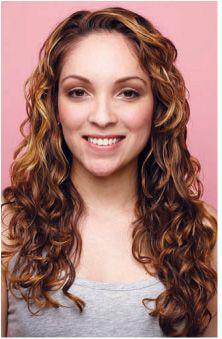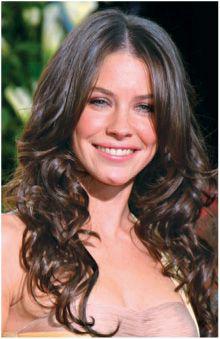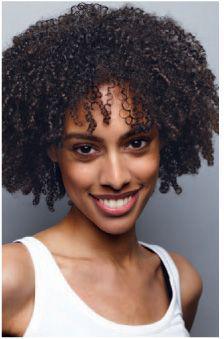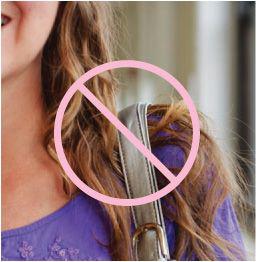B003YL4KS0 EBOK (8 page)
Authors: Lorraine Massey,Michele Bender

DIFFERENT TYPES OF CURLS
S’wavy Hair
Carmine, Curly Girl Model
S’wavy Sample
Evangeline Lily, Actress
You know you have s’wavy curls if you have:•
Hair that may appear straight in the winter with no effort. In fact, you have to work to get waves in your hair. (Read on, because you can do it!)•
Low to no frizz factor.•
A natural shine.•
A slight bend at the ends of your hair, depending on the length.•
Hair that looks better when it’s layered.•
A spring factor of 1 to
2
inches.•
Curly hair needs that extra moisture to stay hydrated and frizz-free.
DIFFERENT TYPES OF CURLS
Fractal or Zigzag Curls
Olivia, Curly Girl Model
Fractal and Zigzag Samples
Laura Izibor, Singer
You know you have fractal or zigzag curls if you have:•
Curls that might be described as twizzles, micro-spirals, or fractal corkscrews.•
An almost steplike pattern to your hair. It may not look zigzag when you look at your hair as a whole, but it will when you take a closer look at individual curls.•
Hair that is relentlessly dry.•
Hair that’s hypersensitive to rough handling.•
Curls that don’t change with the season.•
A receding hairline from having your hair pulled back too tight, relaxed, or the weight of a weave. (All curly girls are prone to this, but fractal and zigzag curls are more so than others.)•
A spring factor of 9 to 16 inches.
CURL CONFESSIONFaith Jones
feminist and writerLike many African American little girls, I had my hair chemically relaxed when I was only four. When I got older, it was a constant battle between me and superstrength relaxers, straightening irons, blow-dryers, and plastic rollers. My life literally revolved around my hair. I scheduled my gym workouts around washing and roller-setting my hair, avoided swimming, and spent hours sweating under a hot hooded dryer, even in the summer. I would walk out of hair salons in tears from the painful chemical scalp burns.
The summer after my college graduation, during a Jamaican vacation, my hair was a frizzy, dry disaster from the sun and swimming. I considered going into town to have my hair braided, but I didn’t want to spend seven hours doing it. Instead, I decided to enjoy my vacation, gross hair and all. I vowed to figure out a way to have this same carefree attitude about my hair when I got home. After searching for solutions, I realized the smartest thing to do was to grow out my relaxer. There were so many ways to transition from straight to curly hair, through straw-sets, braids, Bantu-knotting, and such. But after two months of transitioning, the effort these hairstyles took completely defeated the purpose of wanting carefree styling of my natural curls. The mentality that many black women have about their hair is insane to me. Was I to spend the rest of my life battling with my hair to get it to do something it was never meant to do?
So I went to my hairstylist and had my hair cut off completely. I left happily bald-headed, the sun shining on my scalp, feeling truly liberated. Two years later, my hair is healthy, shiny, and wonderfully curly. After all those years of trying to obtain straight hair, I realized that all my hair needed was moisture and patience! I vowed once my virgin hair grew in that I’d never pollute it with harsh chemicals again.
All hair benefits immensely from good nutrition. The health and radiance of your curls can be directly linked to your diet, says Esther Blum, RD, a New York–based registered dietician, holistic nutritionist, and author of
Eat, Drink, and Be Gorgeous: A Nutritionist’s Guide to Living Well While Living It Up
. “In general, the diet for healthy hair is the diet for longevity,” she says. Specifically, she recommends that you eat your protein. Since hair is 97 percent protein, you need this nutrient to help it grow and stay healthy. Just
2
to 3 ounces of protein three times per day is enough for the average person and 6 ounces three times per day if you’re very physically active. Your healthiest bet is to eat free-range or organic protein because it doesn’t contain hormones or antibiotics and, if possible, to eat meat from animals that are grass-fed.
DON’T SUFFOCATE YOUR HAIR WITH YOUR HANDBAGI see so many long-haired women trap their curls beneath the straps of their shoulder bags. When they realize this, they unconsciously yank the trapped hair out from beneath the strap, ripping and fracturing their curls. Do this a few times every day for weeks and months and it will make one side of the hair appear weak and stringy. Remember to move your hair off your shoulders before slinging on your bag. And if hair does get stuck under the strap, first lift the bag off your shoulder and then move your hair.








